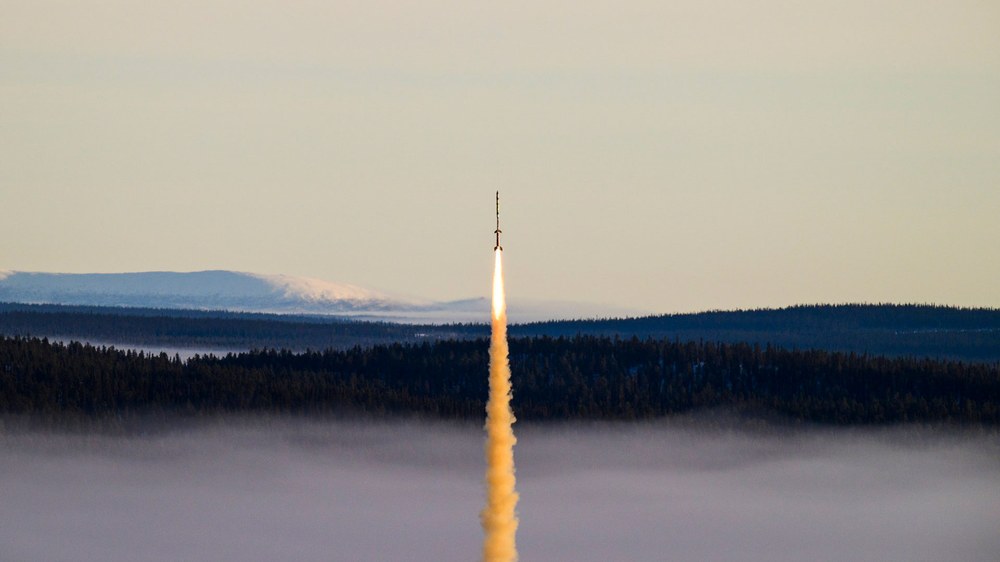Four hundred kilograms of research in microgravity

SSC


- DLR's high-altitude research rocket MAPHEUS 14 has successfully lifted off from the Swedish rocket base ESRANGE.
- It carried out 14 space experiments and was powered for the first time by the new German Red Kite motor.
- Focus: Spaceflight
On 27 February 2024 at 8:27 CET the MAPHEUS 14 high-altitude research rocket, operated by the German Aerospace Center (Deutsches Zentrum für Luft- und Raumfahrt; DLR), successfully launched from the Esrange Space Center near Kiruna, Sweden. The high-altitude rocket reached an altitude of 265 kilometres and provided approximately six and a half minutes of microgravity for its scientific payload – a total of 14 experiments which were all safely recovered following landing. The findings from these experiments will benefit future space missions, the development of technology and materials as well as people on Earth.
MAPHEUS 14 was launched using the new 'Red Kite' rocket motor – a collaborative effort between DLR and Bayern-Chemie – which has now successfully entered regular operations. The second stage of the rocket employed an Improved Malemute, a military rocket motor repurposed for civilian research, also manufactured by Bayern Chemie. This marks a significant milestone as it is the first time that the propulsion system of the high-altitude research rocket has been fully developed by Germany. The DLR Institute of Materials Physics in Space, the DLR Institute of Aerospace Medicine and the DLR Mobile Rocket Base MORABA operate the MAPHEUS research flight series together with partners from Sweden.
"Thanks to its new powerful motor, MAPHEUS 14 marked our most comprehensive and scientifically impactful campaign to date. We hope that this will usher in a new era for the project and our collaboration with numerous external stakeholders," says Thomas Voigtmann, scientific project manager of the mission from the DLR Institute of Materials Physics in Space.
"The Red Kite motor is a good example of cooperation between industry and research. We now have our own motor, a second source, which has been developed according to our flight profile. It fits perfectly with our requirements. This is truly an advantage," adds Felix Huber, Director of DLR Space Operations and Astronaut Training.
Red Kite – booster for research
The new Red Kite solid rocket motor serves as both the first and second stage for multi-stage high-altitude research rockets. It is particularly powerful and allows payloads of more than 400 kilograms. MAPHEUS 14 carried seven experimental units as well as a 'shared module', which accommodated seven small experiments.
The mission involved research organisations from Germany, Sweden, France and Australia. Some carried out unique experiments in materials research and manufacturing to advance technological developments. Others examined human and animal cells to find out how the brain regenerates and how microgravity affects the central nervous system. Patients on Earth should benefit from the findings. The experiments should also contribute to a better understanding of how cancer develops. Another notable achievement was the first completely 3D-printed experiment on board a high-altitude research rocket.
German-Swedish space cooperation
The shared module, for which the Swedish Space Corporation (SSC) was responsible, housed experiments on the Cubesat scale. The MAPHEUS flight served as a technology demonstration for future space experiments on Cubesat satellites. These low-cost small satellites are proving increasingly attractive for universities and commercial users alike.
DLR continued its collaboration with adesso SE throughout the current mission. The German IT service provider actively participated in MAPHEUS 14 with an experiment relating to post-quantum cryptography. The experiment involved testing secure data transmission from space and user authentication for remote control on space missions. The company and the other experiment teams are currently analysing the unique data acquired.
Since the maiden flight 15 years ago, DLR has steadily continued to develop its high-altitude research rocket programme. The successful flight with Red Kite further broadens the experimental horizon for the next MAPHEUS missions.
Related article
About MAPHEUS
DLR's MAPHEUS (Materialphysikalische Experimente unter Schwerelosigkeit; materials physics experiments under microgravity) high-altitude research programme has been utilising sounding rockets since 2009. The project is overseen by the DLR Institute of Materials Physics in Space and the DLR Institute of Aerospace Medicine. The Mobile Rocket Base (MORABA) of DLR's Space Operations and Astronaut Training coordinates the research flights, with the missions executed at the Swedish Space Corporation's (SSC) Esrange launch site.
As part of the MAPHEUS 14 mission, DLR collaborated with the companies Bayern-Chemie and adesso SE, along with a consortium of 12 research institutions: GSI Helmholtz Centre for Heavy Ion Research, Leibniz Institute for New Materials, University of Düsseldorf, Université de Bordeaux, University of Bonn, Technische Hochschule Köln, Stiftung Tierärztliche Hochschule Hannover, La Troube University, Astronomisk Ungdom, ResearchSat, Karolinska Institutet and Royal Melbourne Institute of Technology (RMIT).
